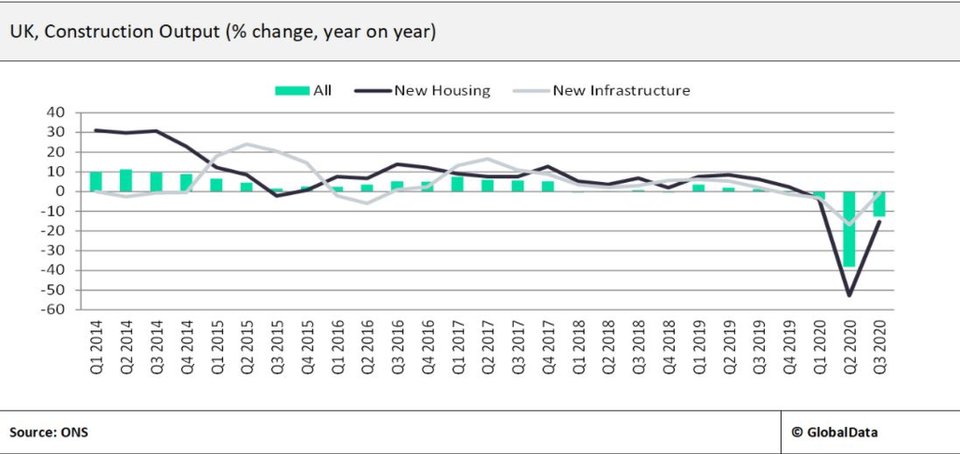Comment
UK construction sector welcomes EU trade agreement but faces a difficult start to the year
Despite the challenges brought on by the coronavirus pandemic and Brexit, the UK’s construction industry is expected to recover in 2021, says GlobalData.
The UK economy has been severely impacted by the Covid-19 outbreak and the political uncertainty over the future relationship between the UK and the EU. The deterioration in economic activity also impacted the construction industry, which has contracted by an estimated 15.1% in 2020.
Although the construction sector was strongly affected by the coronavirus outbreak and the subsequent lockdown measures imposed across the country, it is expected to pick up again this year, with construction work permitted to continue during the new nationwide lockdown that came into effect in early January.

UK construction output took a massive dip in 2020, as this graph from GlobalData shows.
The agreement of a new trade deal between the UK Government and the EU also bodes well for the construction industry. The trade deal ensures zero tariffs on all goods and continued market access for UK firms that trade with the EU. The trade agreement was welcomed by industries bodies, with the Federation of Master Builders stating that the industry would welcome the certainty that the deal will provide.
However, while the deal is preferable to a no-deal Brexit scenario, companies importing from the EU will face additional checks, and construction companies will also find it more difficult to hire workers from the EU due to the end of free movement of labour between the EU and UK.
Mobilising modular
GlobalData expects the construction industry to expand by 6.1% in 2021, following an estimated decline of 15.1% in 2020.
Despite the added difficulties of the new trading arrangements and the lockdown measures imposed by the government on 5 January, the UK construction industry is expected to recover in 2021.
The industry will be supported by the government’s plans to invest in upgrading the country’s infrastructure. In November 2020, the government announced plans for the establishment of a new national infrastructure bank headquartered in the North of England. The government hopes the creation of the infrastructure bank will support its goal of ‘levelling up’ the country, with $36.8bn of funding announced in the National Infrastructure Strategy published in November 2020.
The government’s plans provide a clear commitment to the private sector, showing that it aims to invest significantly in upgrading the country’s infrastructure. The industry’s output will also be supported by Bank of England’s accommodative monetary policy, which is expected to support activity in the residential construction sector.
With the Covic-19 vaccination programme underway and the new trading relationship established with the EU, the construction industry’s outlook is significantly more positive in 2021, but the industry faces a difficult start to the year. Although work on construction sites is permitted to continue, there could be some disruption given the impact of the lockdown on the wider economy.
Despite this, GlobalData expects the construction industry to expand by 6.1% in 2021, following an estimated decline of 15.1% in 2020.
Main image: Bosco Verticale in Milan. Credit: Josè Maria Sava / Unsplash